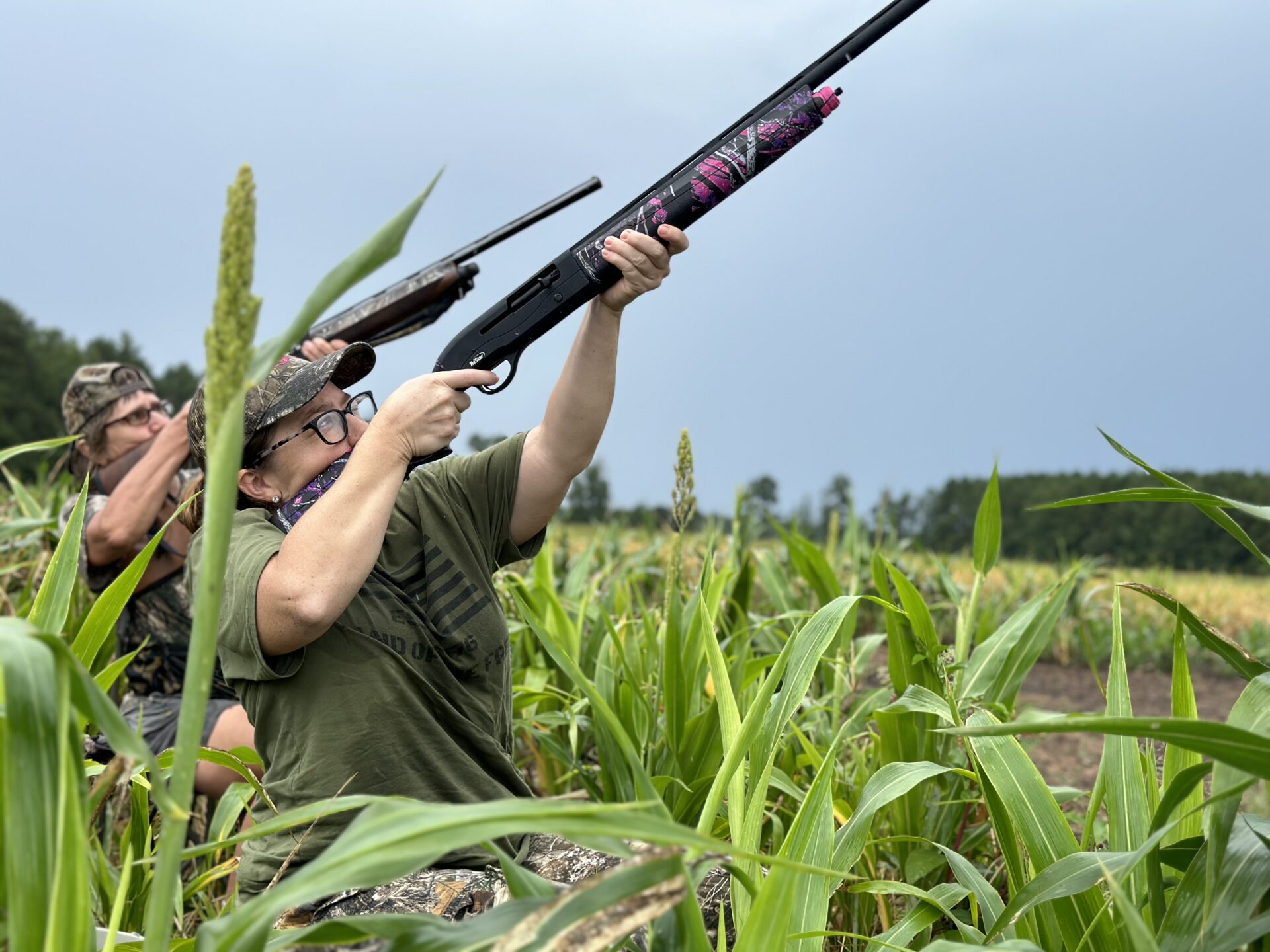Every year for the dove season opener, I giggle at myself. My Tacoma is loaded with gear, shells, my favorite shorthair, Gunner, and extra guns. There’s a palpable excitement in the air and I can’t help but crank up the Pandora on my drive to the dove field. It’s almost like that feeling you had as a teenager headed to Friday night football. You feel more alive, more invigorated, more here.
The dove season opener historically reigns in the hunt season. It signals the close of summer vacations and the beginning of much anticipated hunting trips. Memories will be made across generations as we all gather back on the sunflower fields to cast our gaze high in the sky for those much-anticipated grey ghosts.
Breaking Down the Bird
The Mourning Dove, Zenaida Macroura, is the most abundant and widespread game bird in North America. They inhabit all three of the flyways and even as far south as central America during the migration. Their numbers are considered stable but have been on a slight decline in recent years, particularly in the WMU (western migration unit) due to loss of habitat and farming practices.
A ground dwelling bird with an unmistakable “coo” that carries notes of a haunting lament. Doves are strong little birds in flight but are propped up by weak legs leading them to visually search bare ground for seeds. They can’t scratch the ground like your typical backyard chicken. They require a more accessible meal where they can chow down in the open. Doves will eat 10-20% of their body weight in seeds, filling their crop and then roosting to digest.
The silhouette of a dove is very distinct and there’s no mistaking the whistle made by their wings as they light into the air. Naturals at aerial acrobatics, they have rightly earned the name “grey ghosts” seeming to pop into view out of thin air and then disappearing just as quickly.
Most hunters aren’t aware that doves are banded. About 500 right here in the commonwealth. If you are lucky enough to harvest some redneck bling, please be sure to report it at “ReportBand.gov”. Thanks to the project, a hunter in Florida learned the banded bird he harvested in 1998 was a male banded in Georgia in 1968!
Field Management
Drawing a migrating flock or even resident dove population to a hunt field requires time and resources. It isn’t inexpensive but it is worth every penny and drop of sweat invested.
Sunflowers are high on the dining menu for doves. They will also happily land in millet, wheat and sorghum. Corn is better left until late season as it raises the internal temp of animals and the birds seem to understand that during the hotter months, opting for a lighter but filling meal found in smaller grains.
When managing your dove field, you need as much bare dirt under the crop as possible. If your fields look like a soccer field with lots of grass and weeds, the doves will pass your fields and instead dine at the neighbor’s who carefully eliminated the understory. Timing your crop spray and cuts in the field is also an art. The standing crop should be fully mature and dying back as you cut strips. Be sure to cut at least a week or two before opening day to start drawing in the birds.
About two weeks into September, cut a few more strips to drop more seed and open the ground. This will help hold your current birds and attract more on the migration. It’s important to not over pressure or over hunt the field, doing so will push the birds out in search of safer grounds. Cutting off the hunt by 5p is a great idea so the birds can feed and roost without fear.
Luckily, we have 9 public fields to hunt in Virginia. Ware Creek is listed for dove but has been turned into quail fields and will be removed from the dove listing after this season. Check out the full list complete with maps on VDWR’s website: dwr.virginia.gov.
Prepping for Hunt
Preparing for a dove hunt is one of the easiest as the equipment is minimal and you can typically find a place to hunt within an hour of home. That doesn’t guarantee it’s going to be a barn burner hunt, but you should be able to enjoy a few dove poppers by the end the day.
First, keep it drab and boring. Earth colors are the key to blending in and staying out of sight of those eagle-eyed little daredevils. Never ever put on blue, white or orange. Another big no-no is mirrored and shiny objects – think sunglasses and gun barrels..
You will want a dove stool, bucket or chair. A dove hunt will take a few hours, a little longer if the birds are slow to come into the field. It’s September in Virginia so you’ll want a small cooler to carry refreshing, cold hydration and maybe a sandwich or snack. A hat is pretty much mandatory for a dove hunt not only to block the sun from your eyes but to also shield you from the “rain”.
By the very nature of a dove hunt set up, hunters are scattered all around the edges and within the field. There will be soft, intermittent bb showers and a good hat will shed the shot. This is why safety is paramount. Don’t ever shoot unless you see sky and always mind your muzzle when loading or sitting with the gun on your lap.
Success in the Sky
Hopefully, you had some practice time behind the barrel over the summer. Understanding what chokes and shot your gun prefers is totally a thing. Not all shot is created equally so it’s a great idea to pattern the gun you will use on the hunt along with the choke and shell you prefer.
For those picking up their trusty 20ga, a 1oz shell in #7.5 or #8 is perfect. If you want to throw more bb’s then grab a 12ga and pair it with a 1-1/8oz shell in the same shot size. Most hunters like a hot, fast load 1300+fps for dove, it’s all personal preference and again, pattern your gun and don’t just rely on a shell for your success.
Don’t be stingy on your shell purchase. You will shoot a lot. I mean a whole lot. You can only harvest 15/day but it’s going to feel like you’re using a box of shells per bird! The successful hunters know some key tips and tricks and I’ll happily share them here:
1. Sit. Wait. Too many hunters see birds coming in and get anxious. They fidget or jump up when the birds are still 100 yards out and the birds catch sight of the movement and flare.
2. Tuck In. Find a spot with a tree line where you can tuck in under the branches further breaking up your silhouette. Nestling in among a stand of sunflowers, corn stalks, sorghum or other grain will certainly mask your presence.
3. Keep it Swinging. One of the deadliest methods on wild birds is Swing Through. You often don’t know from where the bird is coming so it normally takes you by surprise. Using swing through allows you to track the flight line, come up through the back of the bird to the front, and pull the trigger just as you pass the head of the bird. Swing Through lets you shoot more birds, sooner. You must be willing to give in to the fact that you are starting behind the bird though. That’s not easy for most shooters. They feel a sense of urgency and want to jump ahead of the bird. The problem is that it’s almost impossible to gauge just how far in front you need to be. Swing Through will let you track the flight path and once your gun comes up to the bird, you just need to push through to the front and pull the trigger.
If you’re taking a pickup dog, be sure they can sit still and are well-mannered. No one wants a dog fight on the dove field, and no one is going to thank you for bringing a dog that “tenderizes” their harvest before they can get it in hand.
Dove hunts are where most youth cut their teeth. I’ve seen more than one six-year-old gleefully charging hard into the field for the retrieve and eagerly zipping it back to mom or dad. These hunts are s a family affair and a welcome sign of the season to come.
I wish everyone a bountiful hunt and a safe season ahead!



